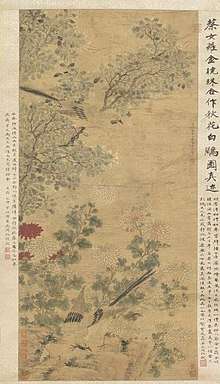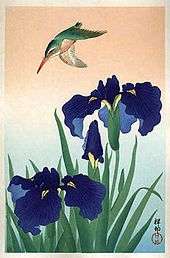Bird-and-flower painting
| Bird-and-flower painting | |||||||
 | |||||||
| Chinese name | |||||||
|---|---|---|---|---|---|---|---|
| Traditional Chinese | 花鳥畫 | ||||||
| Simplified Chinese | 花鸟画 | ||||||
| |||||||
| Vietnamese name | |||||||
| Vietnamese alphabet | Hoa điểu hoạ | ||||||
| Chữ Hán | 花鳥畫 | ||||||
| Korean name | |||||||
| Hangul | 화조화 | ||||||
| Hanja | 花鳥畵 | ||||||
| |||||||
| Japanese name | |||||||
| Kanji | 花鳥画 | ||||||
| |||||||
Bird-and-flower painting (in chinese 花鸟画) is a kind of Chinese painting named after its subject matter. Normally, most bird-and-flower paintings belong to the scholar-artist style of Chinese painting.
History

According to Chinese tradition, bird-and-flower painting covers "flowers, birds, fish, and insects" (Traditional Chinese: 花鳥魚蟲, Simplified Chinese: 花鸟鱼虫 huā, niǎo, yú, chóng). It can thus deal with a wide range of natural topics, including flowers (plants), fish, insects, birds, pets (dogs, cats) etc.
The huaniao hua (花鳥畫) or "bird-and-flower painting" is proper of 10th century China. The most representative artists are Huang Quan 哳㥳 (c. 900 – 965) and Xu Xi 徐熙 (937–975). They are the masters of two schools: the first school was led by Huang Quan (imperial painter). It is characterised by an "outline" method of brush work, with emphasis on bright colours filling a meticulously outline (gongbi). The other school was led by Xu Xi (never entered into officialdom) and typically used techniques associated with ink-and-wash painting.[2]

The bird-and-flower motif started appearing in Japanese art around the Muromachi period of the 14th century, and developed its own distinct style. It also entered ukiyo-e woodblock printing, where it was known as kachō-e (花鳥絵). Especially the shin hanga movement produced a number of works with this motif starting in the Meiji era. Artists working with this were Ohara Koson (1877–1945) and Ito Sozan (1884–?), as well as Imao Keinen (1845–1924).[3][4]
Varieties
According to painting technique:
- Ink wash painting (水墨花鳥/水墨花鳥畫). Representatives: Lin Liang (林良), Qi Baishi (齊白石), Zhang Daqian (張大千)
- Fine-brush (工筆花鳥/工筆花鳥畫)
- Freehand style (寫意花鳥/寫意花鳥畫)
- Fine-brush with Freehand style (兼工帶寫)
See also
References
- ↑ "Early Autumn (29.1)". Detroit Institute of Arts. Archived from the original on 2008-10-02. Retrieved 2008-12-18.
- ↑ Marco, Meccarelli. 2015. "Chinese Painters in Nagasaki: Style and Artistic Contaminatio during the Tokugawa Period (1603–1868)" Ming Qing Studies 2015, Pages 175–236.
- ↑ "hanga gallery . . . torii gallery: Bird and Flower Prints". www.hanga.com.
- ↑ "Keinen kacho gafu 景年花鳥画譜 (Album of Bird-and-Flower Pictures by Keinen)". British Museum.
External links
![]()
- Chinese Flower Painting at China Online Museum
- Chinese Bird Painting at China Online Museum
